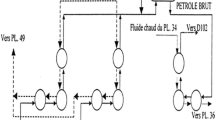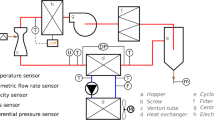Abstract
The overall heat transfer coefficient, pressure drop, and the fouling thermal resistance were compared between a clean and a seawater-exposed, fouled plate-frame heat exchanger. The fouled heat exchanger was utilized for heat recovery from the seawater-effluent for 3 months at a powerplant site. The performance tests were conducted at temperatures of 20 °C and 30 °C on the fouled-side, while the corresponding temperatures on the clean-side were 15 °C and 25 °C, respectively. Flow rate ranged from 20 to 40 l·min−1 on the fouled-side and the clean-side of the heat exchanger. In the absence of fouling, the average U value was higher than that under the fouling condition by 21.3 %. The average thermal resistance ranged from 0.135 m2·K·kW−1 to 0.157 m2·K·kW−1. The pressure drop was less than 2 kPa with the change of temperature, but the pressure drop of the fouled-side increased by 400 % compared with that of the clean-side.
Similar content being viewed by others
Abbreviations
- A :
-
Area, m2
- c p :
-
Specific heat, J · kg−1 · K−1
- D p :
-
Port diameter, m
- h :
-
Heat transfer coefficient, W · m−2 · K−1
- i :
-
Index for measurement parameters
- k :
-
Thermal conductivity, W · m−1 · K−1
- L h :
-
Horizontal port distance, m
- L p :
-
Projected plate length, m
- L v :
-
Vertical port distance (flow length in one pass), m
- L w :
-
Plate width inside gasket, m
- LMTD :
-
Log mean temperature difference, K
- ṁ :
-
Mass flow rate, kg · s−1
- P :
-
Pressure, kPa
- Q :
-
Heat capacity, W
- R :
-
Thermal resistance, m2 · K · kW−1
- T :
-
Temperature, °C
- t :
-
Plate thickness, m
- U :
-
Overall heat transfer coefficient, W · m−2 · K−1
- U :
-
Uncertainty
- β :
-
Chevron angle, degree
- Δ :
-
Difference
- c :
-
Clean
- f :
-
Fouled
- i :
-
Inlet
- o :
-
Outlet
- X :
-
Measured value
- Y :
-
Calculated value
References
Rural Research Institute, A study on the application of thermal discharge from power plant in rural community, Report (2015) 37–38.
Y. G. Lee, J. Heo, D. W. Lee and M. T. Hyun, Construction of the heat pump system using thermal effluents for greenhouse facilities in Jecu and evaluation of cooling performance, Journal of Energy Engineering, 27 (2018) 70–79.
S. B. Genić, B. M. Jacimović, D. Mandić and D. Petrović, Experimental determination of fouling factor on plate heat exchangers in district heating system, Energy and Buildings, 50 (2012) 204–211.
C. Xiao, Y. Qirong, W. Ronghua, Z. Ning and L. Nan, Experimental study of the growth characteristics of microbial fouling on sewage heat exchanger surface, Applied Thermal Engineering, 128 (2018) 426–433.
E. Nebot, J. F. Casanueva, T. Casanueva and D. Sales, Model for fouling deposition on power plant steam condensers cooled with seawater: Effect of water velocity and tube material, International Journal of Heat and Mass Transfer, 50 (2007) 3351–3358.
L. F. Melo and T. R. Bott, Biofouling in water system, Experimental Thermal and Fluid Science, 14 (1997) 375–381.
H. M. Chae, D. A. Cha, O. K. Kwon and J. T. Kwon, The cleaning characteristics of double pipe heat exchanger according to the CaCO3 concentration, Proceedings of Winter Conference of SAREK (2014) 260–263.
T. M. Pääkkönen, M. Riihimäki, C. J. Simonson, E. Muurinen and R. L. Keiski, Crystallization fouling of CaCO3 — Analysis of experimental thermal resistance and its uncertainty, International Journal of Heat and Mass Transfer, 55 (2012) 6927–6937.
D. Yang, J. Liu and X. E., L. Jiang, Model for seawater fouling and effects of temperature, flow velocity and surface free energy on seawater fouling, Chinese Journal of Chemical Engineering, 24 (2016) 658–664.
D. Rubio, C. López-Galindo, J. F. Casanueva and E. Nebot, Monitoring and assessment of an industrial antifouling treatment. Seasonal effects and influence of water velocity in an open once-through seawater cooling system, Applied Thermal Engineering, 67 (2014) 378–387.
B. Bansal and H. Müller-Steinhagen, Crystallization fouling in plate heat exchangers, Journal of Heat Transfer, 115 (1993) 584–591.
S. K. Sung, S. H. Suh and H. W. Roh, A comparative study on the fouling characteristics of river and tap water in a heat exchanging model, Proceedings of Autumn Conference of The Korean Society of Mechanical Engineers (2003) 49–54.
J. H. Heo, D. W. Lee, M. H. Kim, W. K. Baik and R. Yun, Study on effects of seawater fouling on a plate-frame heat exchanger, Korean Journal of Air-Conditioning and Refrigeration Engineering, 29(8) (2017) 391–400.
S. Kakac and H. Liu, Heat Exchangers Selection, Rating, and Thermal Design, Second Ed., CRC PRESS, Boca Raton, USA (2002).
C. E. Kuyatt and B. N. Taylor, Guidelines for Evaluating and Expressing the Uncertainty of NIST Measurement Results, Natl. Inst. Stand. Technol. Tech. Note 1297 (1994).
A. Cooper, J. W. Suitor and J. D. Usher, Cooling-water fouling in plate heat exchanger, Heat Transfer Engineering, 1(3) (1980) 415–496.
D. Rubio, J. F. Casanueva and E. Nebot, Assessment of the antifouling effect of five different treatment strategies on a seawater cooling system, Applied Thermal Engineering, 85 (2015) 124–134.
Acknowledgments
This research was jointly supported by the Korea Institute of Energy Technology Evaluation and Planning (Grant No. 20163010150010), and by the Basic Science Research Program through the National Research Foundation of Korea (NRF), funded by the Ministry of Education, Science and Technology (NRF-2016R1D1A1B02010075).
Author information
Authors and Affiliations
Corresponding author
Additional information
Recommended by Associate Editor Joon Ahn
Wonkeun Baik received the M.E. in mechanical engineering from Hanbat National University, Daejeon, South Korea in 2019. His current research interests are transportation of Captured CO2, and design of plate heat exchanger for power plant.
Rin Yun is a Professor of Department of Mechanical Engineering, Hanbat National University, Daejeon, South Korea. His research interests are utilizing natural refrigerants, transportation of Captured CO2, and gas-hydrate as a secondary fluid.
Jaehyeok Heo is a Senior Researcher of New and Renewable Energy Institute, Korea Institute of Energy Research, Daejeon, South Korea. His research interests include renewable thermal energy hybrid system, thermal storage system, and solar thermal system.
Rights and permissions
About this article
Cite this article
Baik, W., Yun, R. & Heo, J. Experimental study of the seawater fouling on a plate-frame heat exchanger for utilization of waste heat from powerplant. J Mech Sci Technol 33, 5025–5032 (2019). https://doi.org/10.1007/s12206-019-0941-6
Received:
Revised:
Accepted:
Published:
Issue Date:
DOI: https://doi.org/10.1007/s12206-019-0941-6




